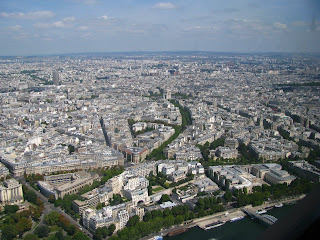If blackberries hadn't come into season before our departure date, I might have handcuffed myself to the Sainsbury’s produce counter to wait them out. That should give you an idea of how much I love British grocery stores. Or at least
Sainsbury's
 |
| My very favorite Sainsbury's store, on Tottenham Court Road. |
Rather than monstrous Wal-Mart type stores where you can shop in expansive warehouse-like buildings for groceries, pharmaceuticals, clothes, tires, garden tools, jewelry, toys (well, you get the idea), stores in London are focused strictly on food and are quite small. This is paradise for people who don't like to cook or even to spend much time in grocery stores feeling guilty about not being able to cook.
 |
| A modern Tesco out on the East End is much more like U.S. stores, spacious with a lot of options and departments. |
Because so many people come into the city to work, Sainsbury's offers prepared lunches ready to go. Not the prepared sandwiches you may have had the misfortune to pick up at certain unnamed stores in the Midwest, but really good sandwiches -- like chicken fajita wraps or chicken and egg salad on whole wheat bread. Sainsbury's has a deal where you can pick up a sandwich or wrap, bottled beverage of up to 750 ml, and either chips or dried fruit for a mere £3. It is the grad student's best friend.
 |
| A variety of sandwiches and wraps in the £3 deal. Add chips or fruit and a drink and you're set. |
The more upscale chain
Marks & Spencer carries that over to dinner, where you came buy a prepared dinner for two -- with wine -- and take it away with you for £10. Many chains have small stores either in the subway stations or just outside them, making it very easy to do a small grocery run each day on your way home from work.
 |
| Marks & Spencer's Dinner for Two. |
 |
| Wine for sale by the (plastic) glass at Marks & Spencer. |
There is a definite emphasis on freshness here. In central London, eggs are not refrigerated and seem to be sold mostly in six packs. Almost all of them are labeled "free-range hen eggs," something we pay extra for in the States. Milk and bread are sold in smaller portions, too, requiring you to replenish more often.
 |
| Eggs. Not refrigerated. |
The produce here is also phenomenal, as I alluded to above. I buy either strawberries or raspberries (or blackberries, now) almost daily. The strawberries are perfect -- all tiny and sweet. Most everything is British grown - or Scottish, as one particular lady noted to me in Sainsbury's one day. She was wearing a rain hat and carting a rolling suitcase for her grocery trip, and we were both practically salivating over the raspberries on display.
 |
| My favorite snack, while the raspberries were in season. |
 |
| A fellow fan of Scottish raspberries. |
Besides freshness, Britons also are much more wary of preservatives than Americans are. Rarely do you find the unpronounceable lists that seem to accompany many of our foods. Dyes are extremely rare, so the color of certain things are different. This preservative fear means you are pretty much shopping organically without intending to do so.
 |
| Ryan drinking a soda from Pret, a local chain restaurant that promotes fresh foods and 'No nasties'. |
There are more American-type stores the farther you get from central London. There are even a few in London itself. And I see the value in having them. But for my short time here, I very much enjoy my daily grocery trips in the tiny stores. Especially now that the blackberries are here.




















































